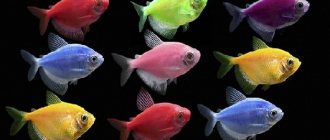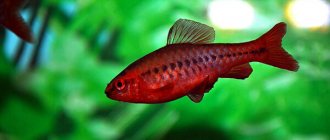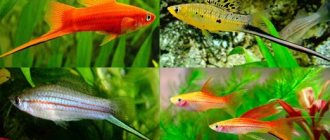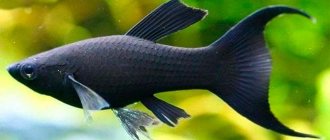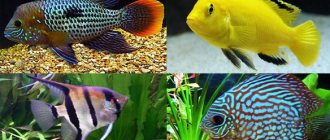You can look at the water forever. And if there are inhabitants there, for example, aquarium fish, this picture will bring peace of mind and put your thoughts in order.
You've probably often seen aquariums in recreational and food establishments. This is all of a psychological nature - to relieve the tense situation around a mass gathering of people, because the sight of a swimming fish will not leave anyone indifferent and home aquariums are no exception. This article will talk about the care, feeding, reproduction and possible diseases of Pecilia.
Spotted poecilia or Platypecilia (Xiphophorus maculatus, Platypoecilus maculatus)
It lives in southern Mexico and Guatemala and inhabits ponds, lakes and lagoons, and is also found in streams and slow-moving rivers. Many people mistakenly think that this beautiful tri-colored platie has a natural color, in fact it is a selected species and there is no need to consider it as natural. Temperature 24…26, dKH <4°; dGH up to 30°, pH 7.2...8.5.
Types of platies
As mentioned, platies are extremely easy to reproduce. This feature led to the emergence of many varieties of these fish. To date, 33 species of the platies genus are known and described, which differ in color and body shape. The most popular of them are Pecilia radish, Pecilia balloon
Pecilia radish
Pecilia radish (Xiphophorus maculatus var) is considered one of the old hybrid forms (this variety was bred in the 70s). The body of this species of platie has a very bright color and an original body shape (the height of the body is almost equal to its length). The fish grow up to 4-5 cm. In natural conditions they live in Central America.
Pecilia balloon
Poecilia sphenops var is a unique fish that was bred artificially. The fish has a curved spine and slightly displaced internal organs - this makes it look slightly bloated. The size of an adult fish is 5 cm. In the wild it lives in Guatemala and Eastern America.
Content
In home aquariums, platy fish usually do not grow more than 3-4 cm and a small aquarium with a capacity of 50 liters or more is suitable for them, but be sure to take into account where 1 cm of fish length should account for 1 liter of water. In an aquarium with platies there should always be clean water and a healthy biological balance, which can be maintained by a large number of aquarium plants: Hornwort, Cirrus, Bacopa carolina, Cryptocoryne-yellow, etc. It is very useful to install a mechanical filter in the aquarium, which will not only clean the water from suspended matter , but also, over time, perform the task of a biological filter.
Telescope fish: diseases, treatment and prevention
So, all the diseases of the fish described come down to the eyes. In most cases, problems arise solely due to insufficient water quality. If white spots or growths resembling a cataract appear before the eyes, then it is necessary to do tests for the content of ammonia, nitrites and nitrates in the water. If these indicators are higher than normal, then it is necessary to replace 20% of the aquarium water daily with settled water. Over time, the disease should go away. In addition, many advise adding iodinol at a rate of 20-25% with each water change. Usually a dose of 10 ml per 100 liters of water is sufficient. This is about 5 drops from a pipette. At the same time, you need to understand that there may be an eye injury that cannot be cured, so all that remains is to worry that the telescope does not catch an infection.
Compatibility with other fish
Platies are compatible with all peaceful fish, but get along especially well with representatives of their own family: guppies, swordtails, mollies, etc. Unlike swordtails, male platies are friendly, except for small skirmishes over the female. And to avoid this, it is necessary that the number of females in the aquarium approximately coincides with the number of males.
Spawning goldfish telescope
The spawning process lasts from April to September. Males at telescopes are smaller and thinner than females. During the breeding season, male goldfish may have whitish bumps on their heads and gills. Manufacturers must best match the selection form of the Black Telescope goldfish, have no body defects, and not lag behind in development from their peers. About a month before spawning, you need to prepare the spawners - place the males and females, feed them generously with bloodworms, daphnia, and earthworms.
Prepare a spawning area - an aquarium with a capacity of 50 - 80 liters. The aquarium should be well ventilated, let the water sit for several days, the temperature should be 20 - 24 degrees. A layer of water of approximately 25 - 30 cm, cover the bottom with coarse sand and place small-leaved algae such as elodea or fontinalis.
For spawning, 2 or 3 males are prepared for one female goldfish. The spawning itself lasts several hours, with the males actively pursuing the female. The female spawns eggs in batches. Some of the eggs settle on plants, some on sand and walls. The first spawning, as a rule, is the most numerous - up to 3000 eggs; the age and health status of the female Black Telescope is of great importance.
Start
Diseases
Platy fish, like other fish, are prone to various diseases. But in most cases they are caused by improper fish keeping. Any deviation from the norm: hypothermia, poor nutrition and even stress weakens the fish’s immune system and can cause illness.
For example, the platies that I am now telling about were brought to me by a friend of mine from the city of Samara. Evgeniy is an experienced aquarist and he could not buy sick fish, but the platies still fell ill with ichthyophthyriasis. I was in no hurry to use medications, realizing that there is an excellent remedy that will restore the fish’s body, give it back its strength and help get rid of the disease, and this remedy is live food. This is true! After only a week of feeding the platies with live daphnia, the fish began to improve and recovered.
Note: Ichthyophthyriasis is a simple disease of aquarium fish and in most cases affects fish with a weakened immune system. The causative agent is a parasitic ciliate that parasitizes the body of fish and fins. Symptoms: scratching the fish on the ground and various objects. Compression of the fins and the appearance of white grains on the body of the fish and fins. Aquarists often call this disease “semolina.” For treatment they use: salt baths, drugs: bicillin-5, rivanol, etc.
Feeding
Platy fish are omnivorous and happily eat dry food: daphnia, gammarus, as well as commercially produced food. But the diet of fish should at least occasionally contain live food. This could be: bloodworms, coretra, tubifex, aulophorus, daphnia, etc. You can also use frozen live food, but it will be much worse for fish to eat.
Spirulina tablets have worked well as herbal supplements. You can feed the fish a small amount of washed bread crumb or steamed semolina. Platies need less plant food and therefore can be included in the diet less often and in small quantities, but live food, on the contrary, should be given paramount importance.
Note: when I started getting into aquarium farming, I was plagued by failures. The fish did not live long, they often got sick and died, and I never dreamed of starting fish breeding at that time. But over time, I had to understand an important thing: success in keeping and breeding fish is inextricably linked with live food. Now I can no longer imagine aquarium farming without live food. Thanks to live food, I was able to breed many types of fish, and aquarium keeping became much more interesting.
To provide my fish with live food, I breed Aulophorus and Daphnia moina. These types of live food lend themselves well to cultivation, and Daphnia moina can also become an irreplaceable starter food for many species of fish. Read more in detail in the publication “Daphnia”.
What to feed your platie?
Platies are omnivores, like most species of aquarium fish.
They readily consume live, dry and frozen food. To feed these miniature fish, they choose food with small particles, because large fish can simply choke on food. Live food includes bloodworms, tubifex, daphnia and cyclops. Sometimes they offer herbal supplements - chopped spinach leaves, lettuce or seaweed. The fish are fed in small portions, which should be eaten completely and quickly. A balanced and varied diet has a positive effect on the growth, color and activity of platies.
Pregnant platy
A pregnant platy is easily distinguished by its swollen abdomen. And if a pregnant female has fairly transparent skin in the abdominal area, you can also see the black eyes of the larvae. The approach of the first birth must be determined only visually. But only later, during repeated births, it will be possible to navigate quite accurately by the birth intervals.
Not long before giving birth, the female’s abdomen takes on a slightly angular shape. At this time, it is better not to take risks and place the female in a special aquarium, otherwise the birth will take place in a general aquarium and the fry will be eaten. For the birth of platies, it is necessary to prepare a special nursery. This could be: a small aquarium with dense thickets of plants, a plastic tank, or just a three-liter jar.
For the birth of platies and swordtails, I use a six-liter plastic tank with a closing lid. The volume of the tank will allow you to retain oxygen in the water for a long time in case the birth is delayed, and the lid will prevent the female from accidentally jumping out of the tank.
I shade the tank with the pregnant female with a light-proof bag. In the morning and evening, I open the package slightly and check: if there was no birth, I feed the female and shade the tank again. After giving birth, I return the female to the general aquarium, and transfer the fry to the nursery aquarium.
How to distinguish a male and a female?
Sexual differences in platies can be seen quite well. Individuals of different sexes, first of all, differ in size - females are much larger than males. The color of males is brighter, females are more modestly colored. The anal fin of the male is modified into a gonopodium (a special organ that is used during reproduction); in the female this fin is wider.
Plaecia fry
Tri-colored platies fry are born similar to swordtail fry. But after 1-2 weeks they can be distinguished by a denser and shorter body, as well as two small black spots located at the edges of the base of the caudal fin.
As a starting food for platie fry, I use live food of Daphnia moina, which I breed at home. You can learn how to breed Daphnia moin, as well as purchase a culture for breeding, from my publication “Food for Daphnia fish.”
For the first week, I don’t turn off the light in the aquarium at night to provide the fry with round-the-clock nutrition. After a few days, when the fry grow up, I start giving them aulophorus. Platy fry eat very well and grow quickly. Closer to the month, I prepare the fry for transplantation into a general aquarium and accustom them to dry daphnia and gammarus.
Appearance of a goldfish telescope
Among more than 125 artificially cultivated species of goldfish, the Black Telescope rightfully occupies a special place. Brought out in the 17th century in China, over three centuries it spread across almost all continents as a perfect example of aquarium art. Indeed, once you see this creature, it is impossible to forget it. A round or egg-shaped short body, a flowing or butterfly-shaped forked tail, a vertical fin and huge bulging eyes. Or rather, it would be correct to say, not eyes, but peculiar telescopes on the sides of the head. “Eyes” can be round, cylindrical or cone-shaped and sometimes protrude by 2 cm. The fish grows its telescopes by about 6 months. The most prized telescope is the one with symmetrical eyes. The scarier the fish looks, the more it resembles a smaller copy of a hammerhead shark.
The features of the black telescope are not limited to these features. The unusual velvet scales of a noble black color deserve close attention. The more uniform the coloring, the more valuable the specimen. True, such scales do not appear in the fish immediately, but as they grow older, and by old age the fish usually “greys,” acquiring a bronzed or grayish tint. However, a healthy and well-maintained black telescope, or Dragon's Eye as it is also called, looks very impressive and is worth the expense and effort. The length of the fish reaches 10 - 15 cm, but giants up to 25 cm long can also be found. Life expectancy is 15 years, long-bodied varieties live up to 30, apparently this is due to better immunity compared to “round” species.
Start
